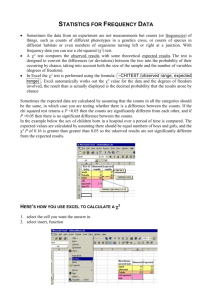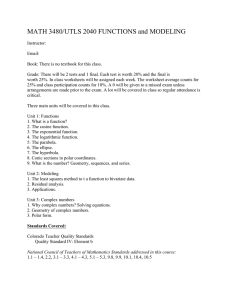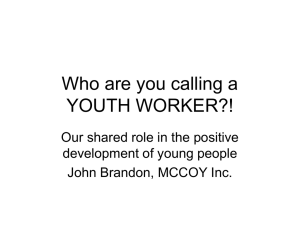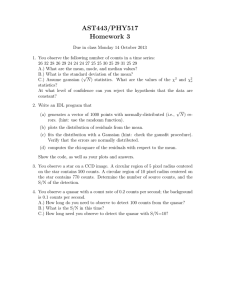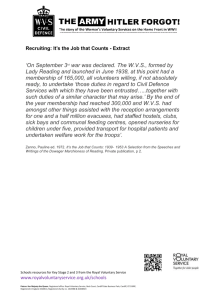ACCESS Substitution ciphers Notes for Tuesday June 12
advertisement
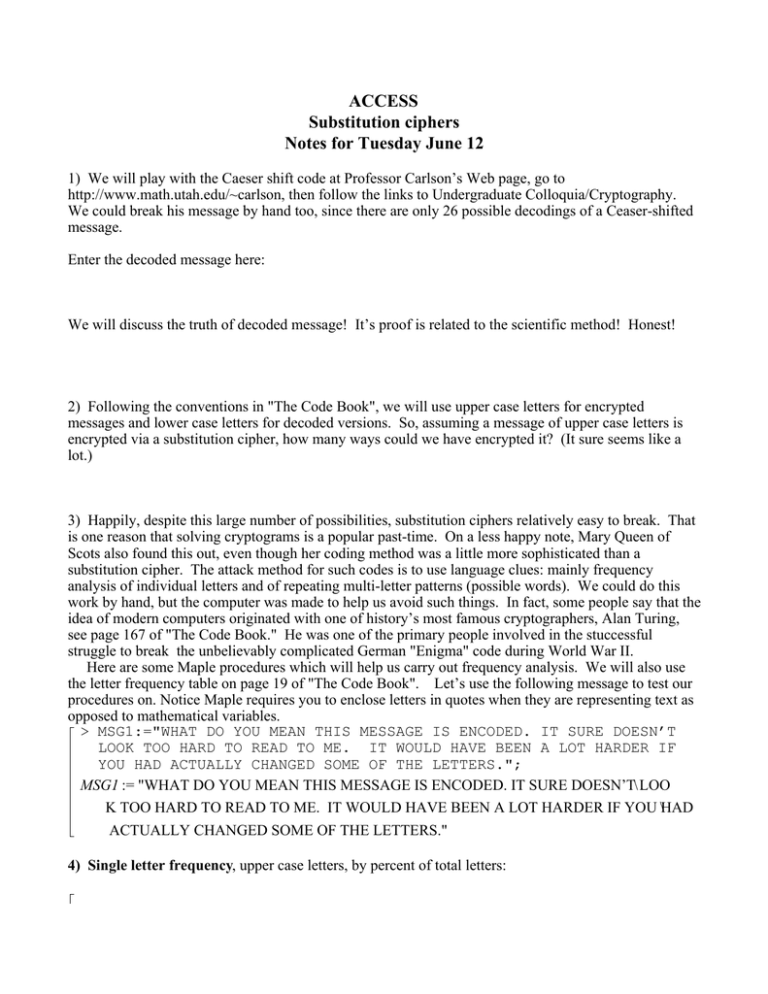
ACCESS Substitution ciphers Notes for Tuesday June 12 1) We will play with the Caeser shift code at Professor Carlson’s Web page, go to http://www.math.utah.edu/~carlson, then follow the links to Undergraduate Colloquia/Cryptography. We could break his message by hand too, since there are only 26 possible decodings of a Ceaser-shifted message. Enter the decoded message here: We will discuss the truth of decoded message! It’s proof is related to the scientific method! Honest! 2) Following the conventions in "The Code Book", we will use upper case letters for encrypted messages and lower case letters for decoded versions. So, assuming a message of upper case letters is encrypted via a substitution cipher, how many ways could we have encrypted it? (It sure seems like a lot.) 3) Happily, despite this large number of possibilities, substitution ciphers relatively easy to break. That is one reason that solving cryptograms is a popular past-time. On a less happy note, Mary Queen of Scots also found this out, even though her coding method was a little more sophisticated than a substitution cipher. The attack method for such codes is to use language clues: mainly frequency analysis of individual letters and of repeating multi-letter patterns (possible words). We could do this work by hand, but the computer was made to help us avoid such things. In fact, some people say that the idea of modern computers originated with one of history’s most famous cryptographers, Alan Turing, see page 167 of "The Code Book." He was one of the primary people involved in the stuccessful struggle to break the unbelievably complicated German "Enigma" code during World War II. Here are some Maple procedures which will help us carry out frequency analysis. We will also use the letter frequency table on page 19 of "The Code Book". Let’s use the following message to test our procedures on. Notice Maple requires you to enclose letters in quotes when they are representing text as opposed to mathematical variables. > MSG1:="WHAT DO YOU MEAN THIS MESSAGE IS ENCODED. IT SURE DOESN’T LOOK TOO HARD TO READ TO ME. IT WOULD HAVE BEEN A LOT HARDER IF YOU HAD ACTUALLY CHANGED SOME OF THE LETTERS."; MSG1 := "WHAT DO YOU MEAN THIS MESSAGE IS ENCODED. IT SURE DOESN’T\ LOO K TOO HARD TO READ TO ME. IT WOULD HAVE BEEN A LOT HARDER IF YOU \HAD ACTUALLY CHANGED SOME OF THE LETTERS." 4) Single letter frequency, upper case letters, by percent of total letters: > count1 := proc(Z) local C, counts, L, i; #Z is a string of characters # Character being processed # Table of character counts # Length of Z #index for C from "A" to "Z" do counts[C] := 0 od; #initialize counts array L:=length(Z); #L is the number of characters in Z # Get character count: for i from 1 to L do C:=Z[i]; if C >= "A" and C <= "Z" then counts[C] := counts[C] + 1 fi od; # Display a table of the counts. for C from "A" to "Z" do print(C,evalf(100*counts[C]/L)); od; end: count1 our test message! How do the percentages compare with the table on page 21? 5) 2 letter word counts - actual words > count2 := proc(Z) #written assuming message has #kept punctuation, to count #two letter words local C1,C4, # non-letter characters C2,C3, #letter characters i, #index in list counts, #Table of word counts L; #List length # Clear the table of character counts. for C2 from "A" to "Z" do for C3 from "A" to "Z" do counts[C2,C3] := 0 od;od; L:=length(Z); for i from 1 to L-4 do C1:=Z[i]; C2:=Z[i+1]; C3:=Z[i+2]; C4:=Z[i+3]; if (C1 < "A" or C1 > "Z") #C1 not a letter and (C2>="A" and C2<="Z") #C2 a letter and (C3>="A" and C3<="Z") #C3 a letter and (C4<"A" or C4>"Z") #C4 not a letter then counts[C2,C3]:=counts[C2,C3]+1; fi; od; # Display a table of the counts, if they have at least # one occurence: for C2 from "A" to "Z" do for C3 from "A" to "Z" do if counts[C2,C3]>=1 then print(cat(C2,C3),counts[C2,C3]); #cat is the concatinate command fi; od;od; end: > Test count2 on our message 6) 3 letter words > count3 := proc(Z) #three letter words local C1, C5, #non-letters C2,C3,C4, #letters i, #index in list counts, #Table of character counts L; #List length # Clear the table of character counts. for C2 from "A" to "Z" do for C3 from "A" to "Z" do for C4 from "A" to "Z" do counts[C2,C3,C4] := 0 od;od;od; L:=length(Z); for i from 1 to L-4 do C1:=Z[i]; C2:=Z[i+1]; C3:=Z[i+2]; C4:=Z[i+3]; C5:=Z[i+4]; if (C1<"A" or C1>"Z") and (C2 >= "A" and C2 <= "Z") and (C3>="A" and C3<="Z") and (C4>="A" and C4<="Z") and (C5<"A" or C5>"Z") then counts[C2,C3,C4]:=counts[C2,C3,C4]+1; fi; od; # Display a words with non-zero counts for C2 from "A" to "Z" do for C3 from "A" to "Z" do for C4 from "A" to "Z" do if counts[C2,C3,C4]>=1 then print(cat(C2,C3,C4),counts[C2,C3,C4]); #cat is the concatinate command fi; od;od;od; end: Test it! 7) YOUR GROUP ASSIGNMENT FOR TODAY: Decode the following message. Create a Microsoft Word document in which you include both the coded and decoded message, and also include the decoding key. Email your document to me, korevaar@math.utah.edu, as an attachment. Make sure you list your group members at the top of your document. Hint: You may want to see Appendix B, page 391 of "The Code Book." > MSG2:="SDDUNN HN S NDPGCSMNPHJ QPSQ GOOUMN SJJMGYHESQUCW QXUFQW XGEUF TFHKTU UYJUMHUFDUN SFR GJJGMQTFHQHUN HF NDHUFDU SFR QUDPFGCGLW. SF SDDUNN NDPGCSMNPHJ MUDHJHUFQ NJUFRN QPU NTEEUM GO PUM OMUNPESF WUSM XHQP NGEU GO QPU IMHLPQUNQ XGEUF UFQUMHFL QPU TFHZUMNHQW GO TQSP. HF S NJUDHSCCW RUNHLFUR DGTMNU QSTLPQ IW NGEU GO QPU TFHZUMNHQW’N EGNQ UFQPTNHSNQHD SFR DUCUIMSQUR JMGOUNNGMN, NPU HN HFQMGRTDUR QG PSFRN-GF UYJUMHUFDU XHQP MUSC-XGMCR JMGICUEN QPMGTLP HFNQMTDQHGF, CSIGMSQGMW XGMB SFR QUSE XGMB GF SNNHLFUR JMGAUDQN. QPU DCSNN HN NJUDHSCCW RUNHLFUR QG LHZU JSMQHDHJSFQN FGQ GFCW ZSCTSICU CSIGMSQGMW UYJUMHUFDU, ITQ SCNG S QSNQU GO USDP GO QPU ESAGM NDHUFDUN.";
